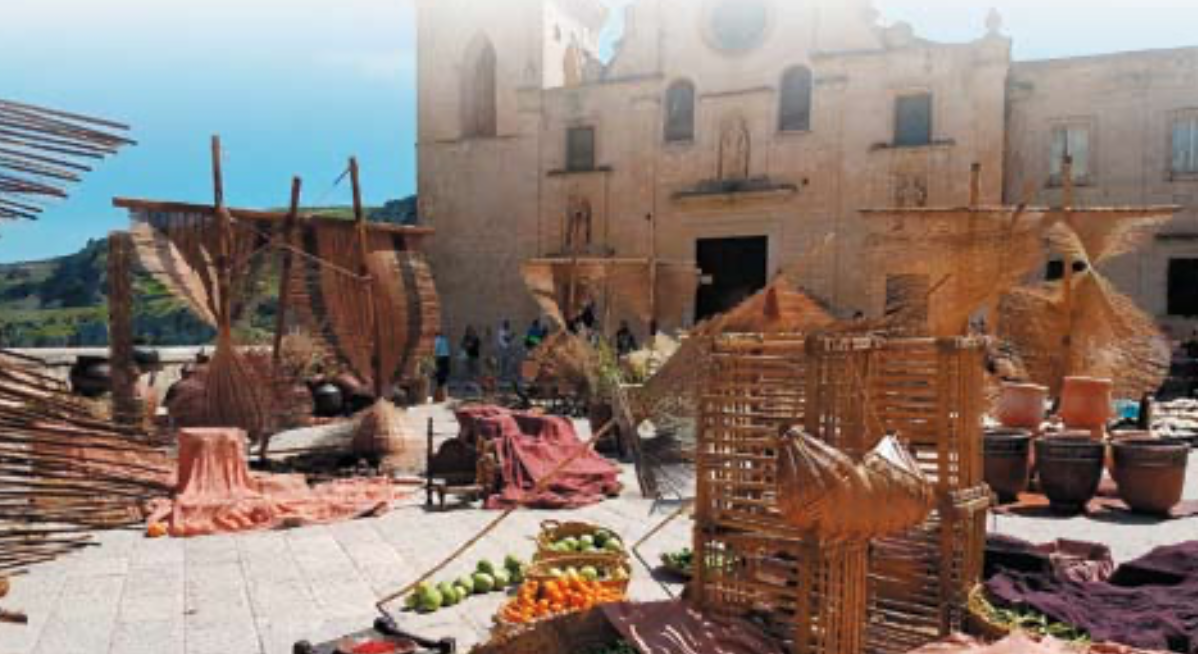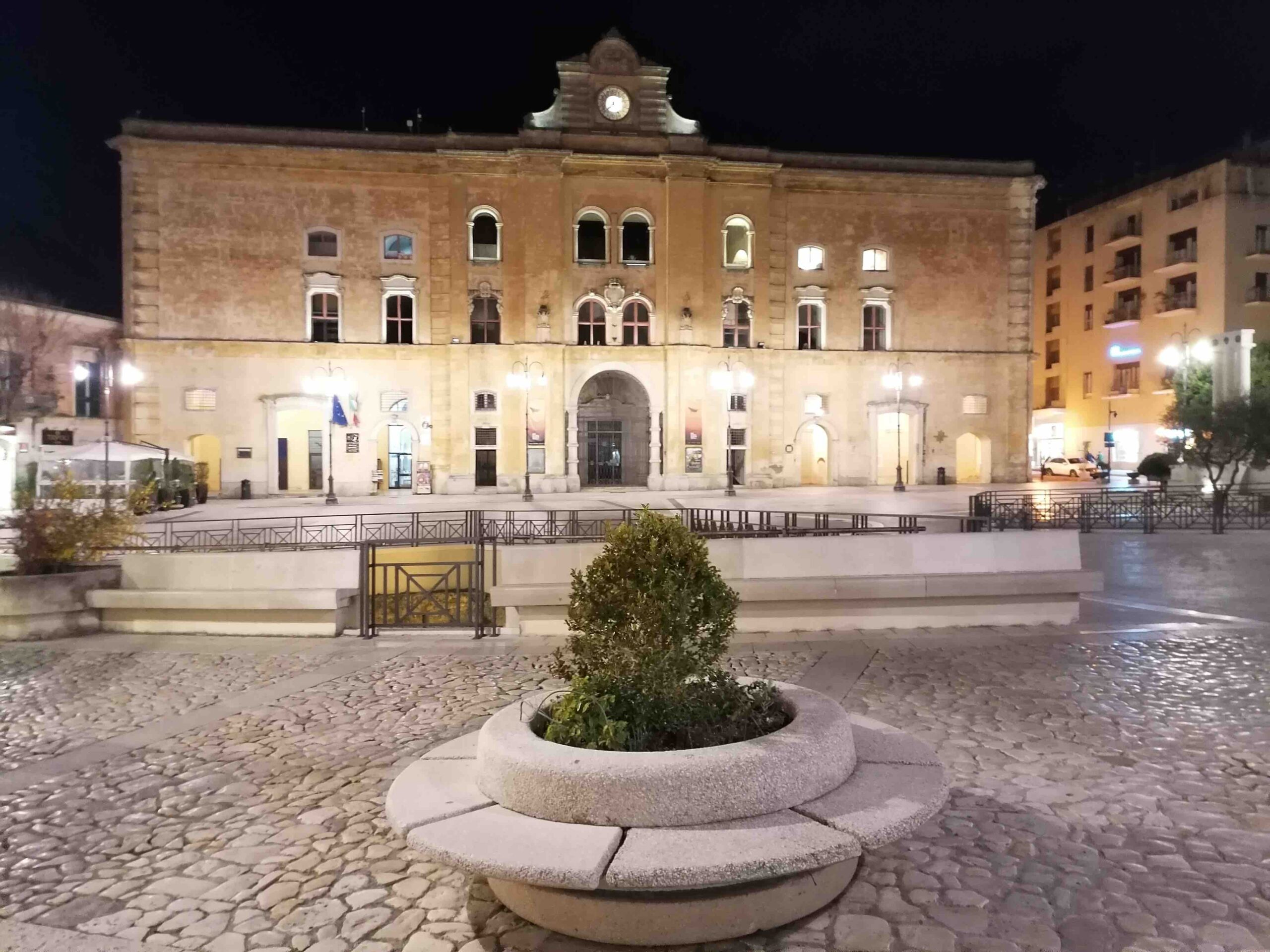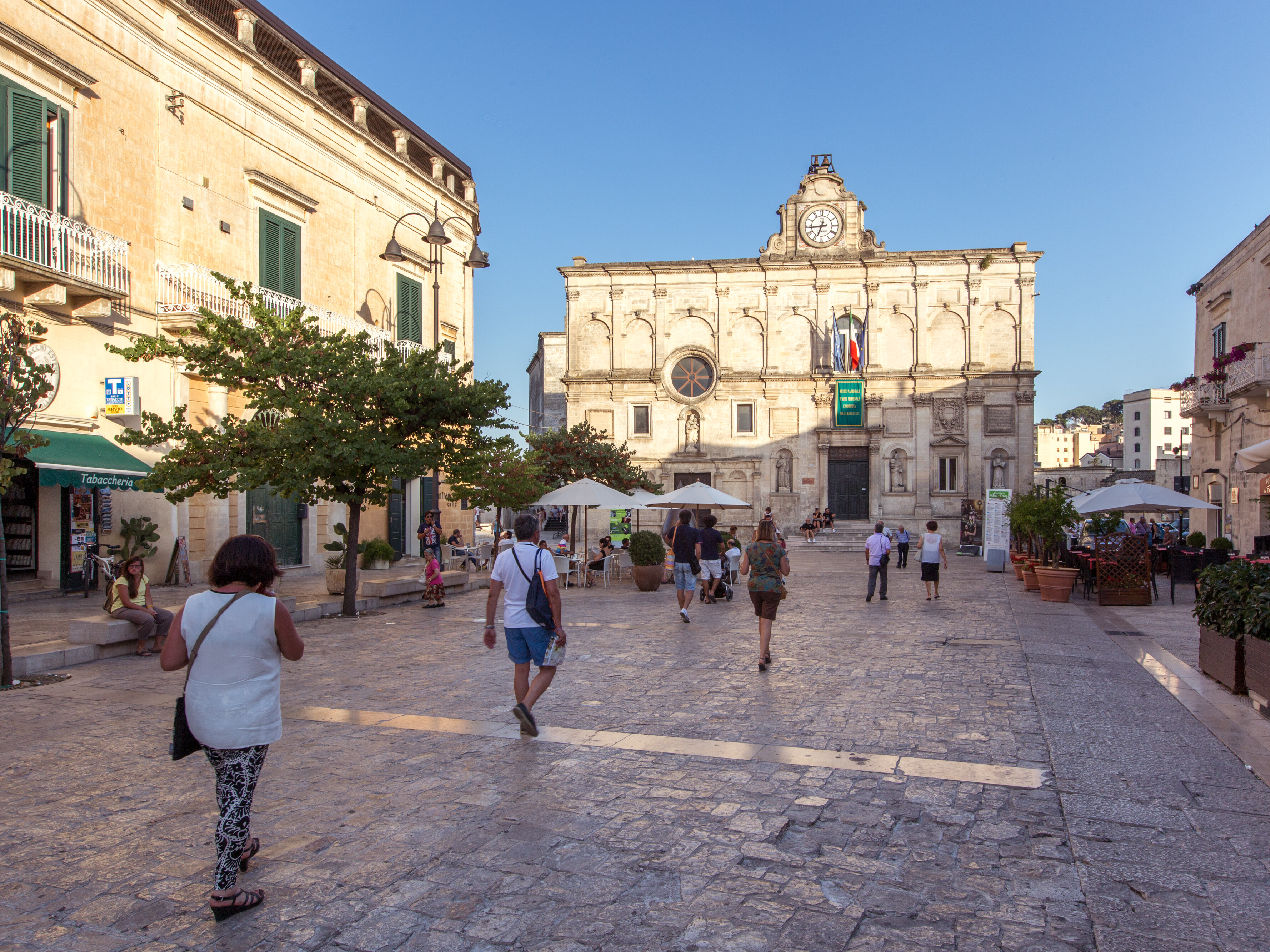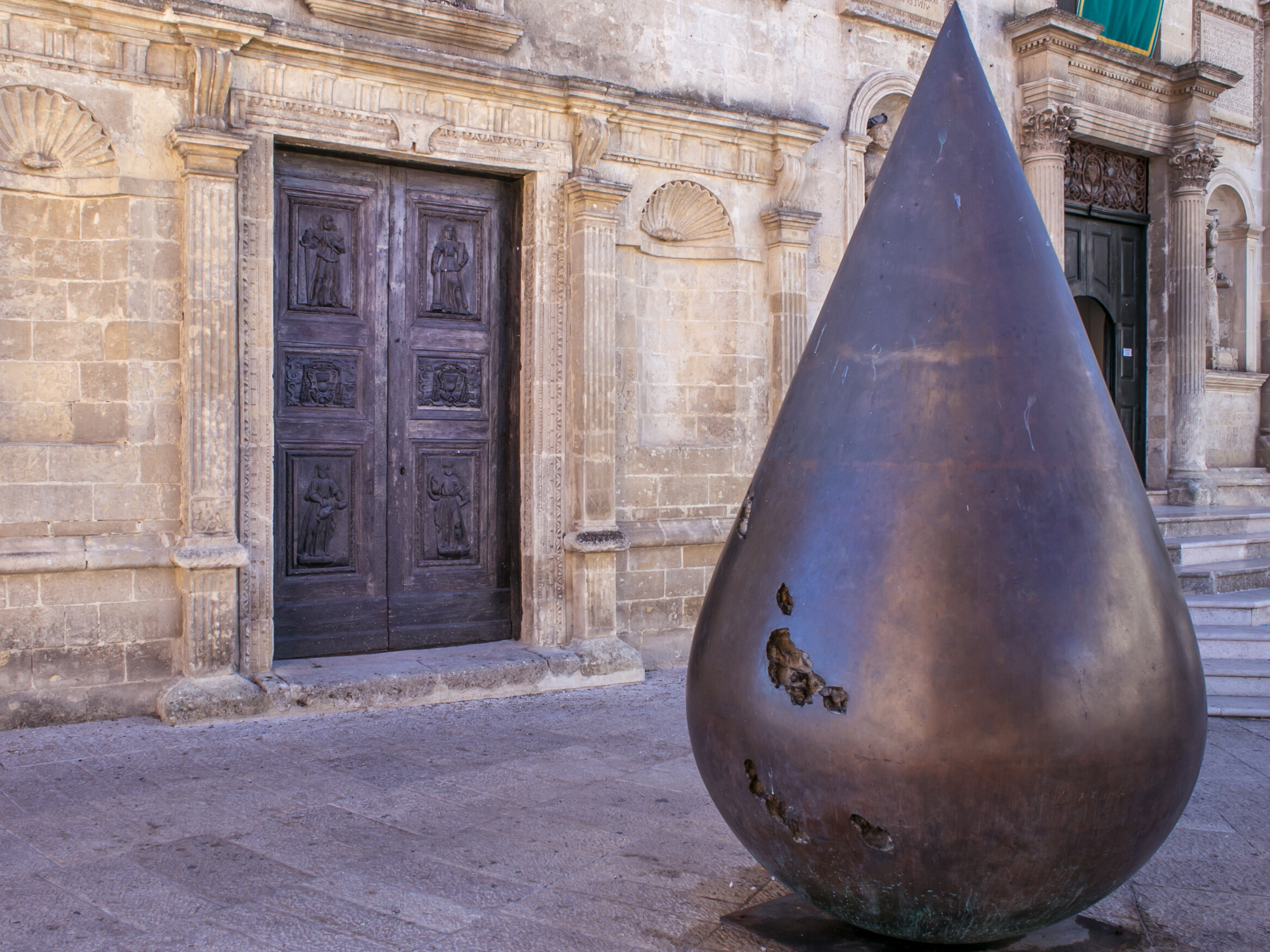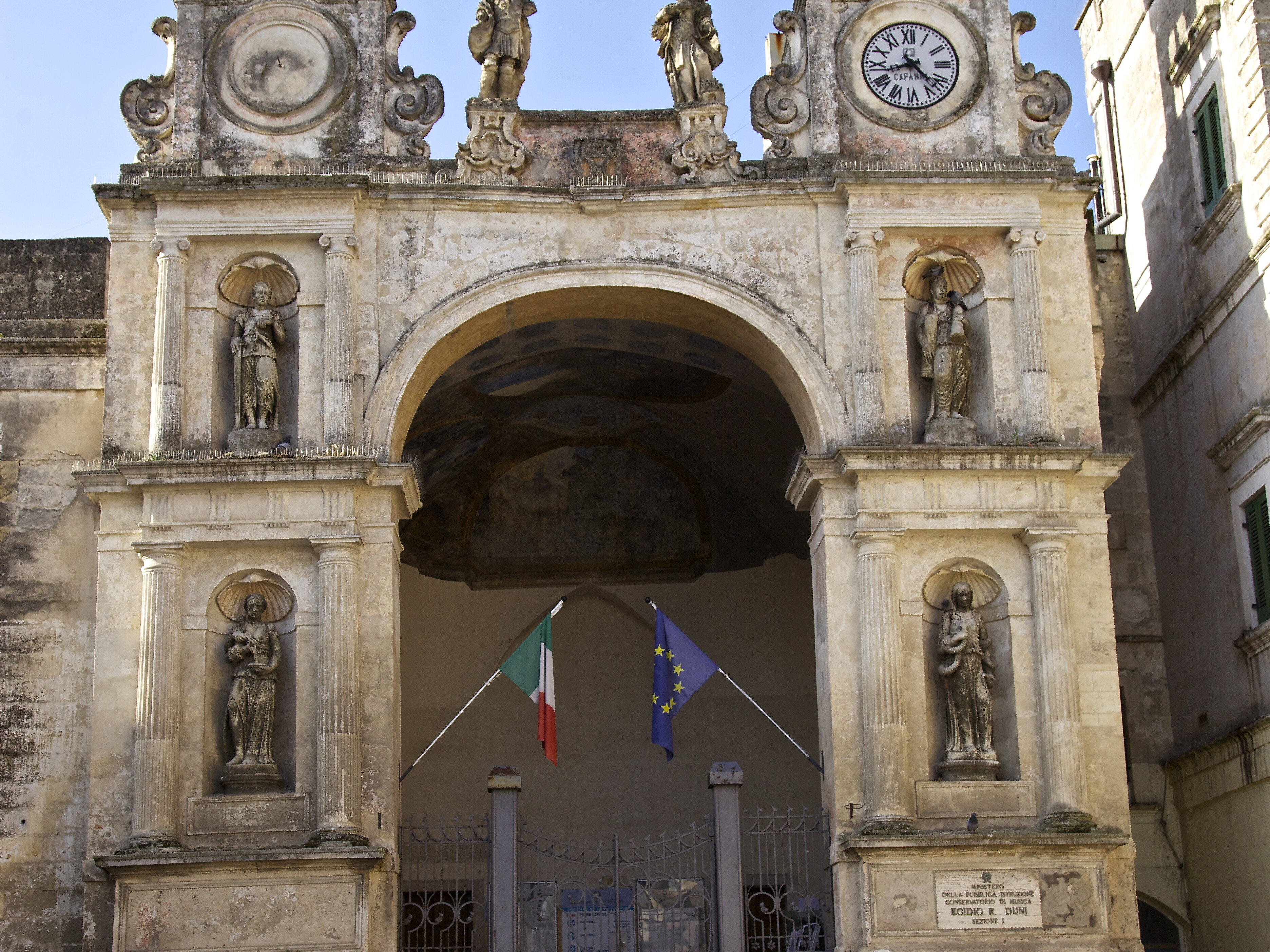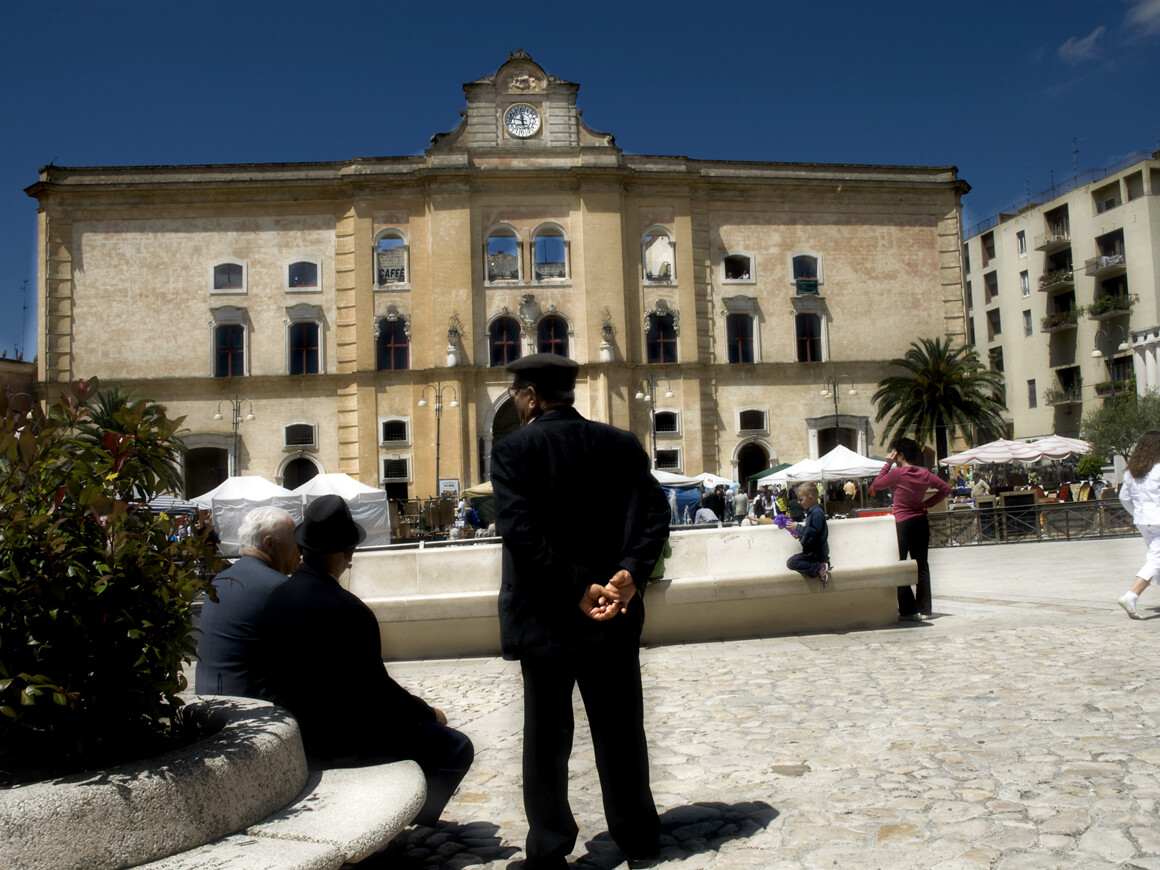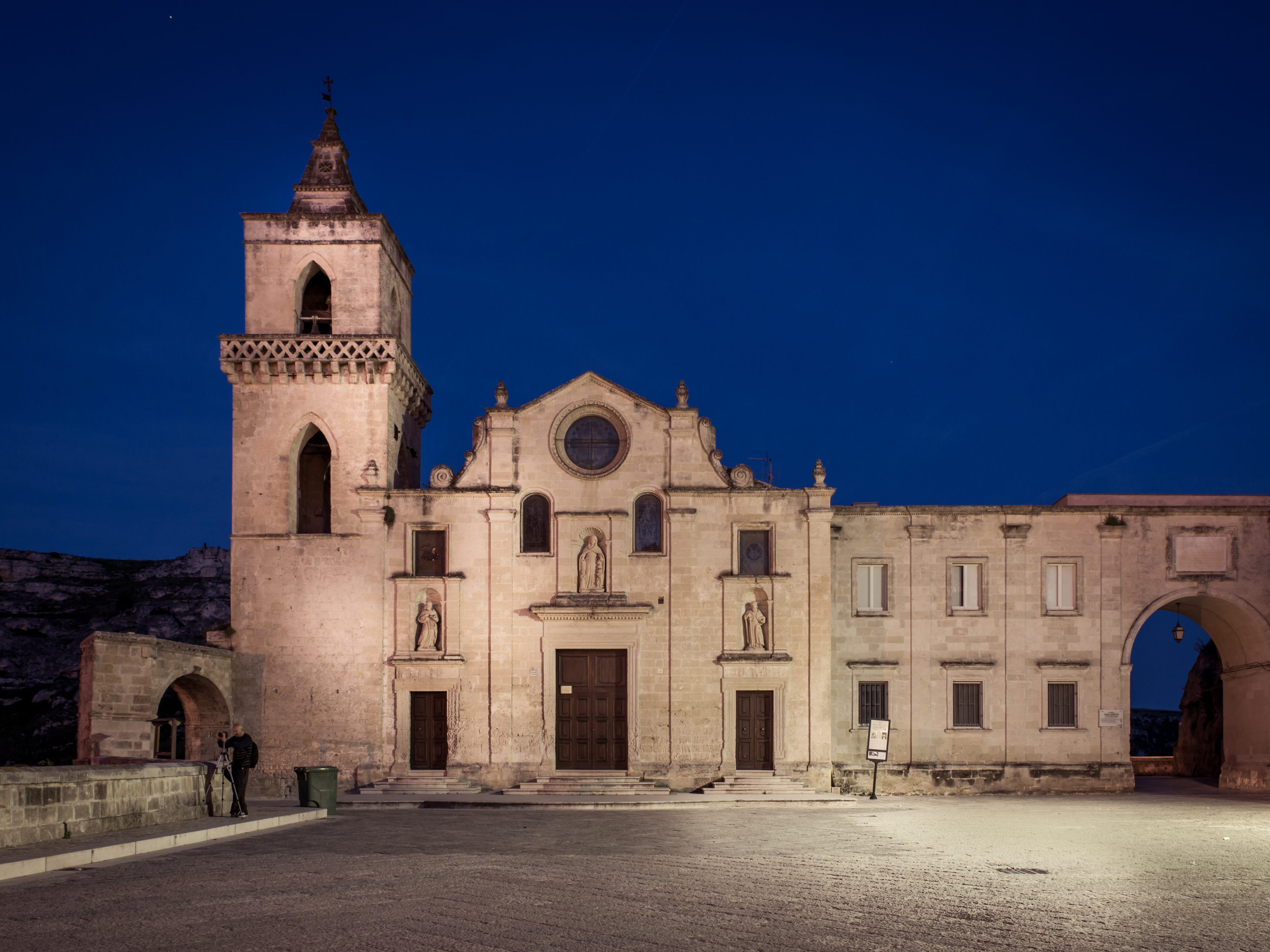Matera movie tour
Matera Tour
Matera like Jerusalem
From Matera, the set of film sets, begins a journey of discovery of the most evocative locations chosen by the great international filmmakers. The “manger of miracles” is unveiled by the directors who staged their story of Jesus Christ in those places that are so symbolic of the centuries-old city: The Gospel according to St. Matthew by Pier Paolo Pasolini (1964), King David by Bruce Beresford (1985), The Passion of the Christ by Mel Gibson (2003) and The Nativity Story by Catherine Hardwicke (2006). The tour covers all the most important sites of the evangelical narrative: spaces and places that on the silver screen have revealed all their splendour, delighting our eyes and moving our hearts.
Via Muro
Panoramic, stunning, spectacular. Via Muro is the starting point of the tour on the Passion of Christ which has hosted the great directors Mel Gibson and Catherine Hardwicke. In the film The Passion of the Christ, Via Muro is the place on the Way of the Cross where, in the midst of his Calvary, Jesus begins his journey towards his destiny. Although he denies it, Mel Gibson allowed himself to be inspired by the great Pier Paolo Pasolini who had previously chosen Matera for its similarity to Palestine. The maestro and poet, who inaugurated biblical films in the city of the Sassi, chose instead Via Lombardi to film the scenes of the Way of the Cross. A road where humanity and spirituality blend together, leaving space for the imagination and the unending horizon of Golgotha. In her film on the Nativity, Catherine Hardwicke designed a set around the spectacular flight of steps in Via Muro with a great door, exotic palm trees and stalls for the sale of wares, turning it into a meeting place and market for the inhabitants of the village. Via Muro stretches as far as the ancient quarter of Civitas, where the cathedral arises majestically, with Piazza San Pietro Caveoso, where the church of San Pietro Caveoso stands, towering above the canyon. Here along Via Muro is where the Prince’s stately home was set for the American remake of “Ben Hur” (2015).
San Pietro Caveoso
Piazza San Pietro Caveoso, immortalised by great directors both Italian and foreign, was a location chosen also for other stage sets, by the Taviani brothers in their masterly film Il Sole anche di notte (1990), by Giuseppe Tornatore in L’uomo delle stelle (1995) and by Ferdinando Arrabbal in the film L’albero di Guernica (1975). Piazza San Pietro Caveoso was also used as the setting for the entrance to the Roman Camp of Jerusalem in the film “Ben Hur” (2015), as well as for the outdoor market, rich with spices, urns and ancient braziers in the film dedicated to the super hero “Nightingale” (2016).
Malve District
At the back of Piazza San Pietro Caveoso you go towards the Malve Quarter, an evocative film location where, in the Hol- lywood director Gibson’s film, the commercial activities of Je- rusalem are carried out. Stalls, exotic plants and utensils, jugs and furnishings of the time decorated the set of the ancient marketplace and the homes of Jerusalem. The place has a wealth of interest and history, and amidst the rock churches and deep caves, the tribulations of the film King David were also set. And the collosal American film “Ben Hur”.
Porta Pistola
The crossroads between the Sassi and Porta Postèrgola, better known as Porta Pistola, looks over the spectacular gullies of the canyon where the Gravina river flows.
The place, chosen by both Pier Paolo Pasolini and Mel Gibson, represents the Gates to the city of Jerusalem, the Holy Land, prepared with a monumental set design characterised by Ara- bic-style architectural elements.
Madonna delle Virtu’ and San Nicola dei Greci
Just a few steps away from the Gates of Jerusalem arises a marvellous rock complex: Madonna delle Virtù and San Nicola dei Greci where the scene of the Last Supper was filmed in the Hollywood epic.
Words of love alternate with blood and nails, the Lamb of God takes away the sin of the whole of humanity before the cross is planted in the ground and raised on Golgotha, in Murgia Park, for his death and Resurrection.
Murgia Park
Murgia Park, with its natural, historical and ecological patrimony, is of exceptional value on a universal level. Beyond the canyon, like an island, it bursts into space without boundaries or obstacles. The scenery speaks of human tribulations from the very origin of life until our times, and its immense landscapes have inspired directors and writers. It was in the area of San Vito that Pier Paolo Pasolini decided to set the scene of the Holy Sepulchre and the appearance of the Archangel Gabriel. In The Passion of the Christ, on the other hand, the life of Jesus as a child is depicted, in an intense and mystical flashback, in one of the rural buildings of the area, Radogna Farm.
Also Catherine Hardwicke reconstructed the village of Bethlehem in the Murgia Park – in the rock church of San Pietro in Princibus – and, in Selva Venusio, the village of Nazareth. Full of spirituality, it was also used for the set of the film “The Young Messia” (2015). Used as the setting for the place where Morgan Freeman’s character was imprisoned in “Ben Hur” (2015), the Park of the Materan Moors was also immortalized in some of the adrenaline-filled scenes from the film “Veloce Come il Vento” (2016). It was also here that Amazon women galloped on horseback, set against the backdrop of the Moors, not far from the church of the Madonna delle Vergini, from the film “Wonder Woman” (2016).
Golgota
It is in Murgia Timone that Golgotha rises. Evocative and mystical, it was the setting for the Crucifixion scenes in the films of Pier Paolo Pasolini and Mel Gibson.
The Golgotha prepared by Hardwick sees the crosses as representing the death sentence of the time. Golgotha is the last stop in Matera on the biblical theme movie tour which leaves, in the eyes of the spectators, the enchanting images of the manger of miracles.
“Around Matera: from Murgia Park to the Crypt Of Original Sin” Itinerary
Matera Tour
In 1993, UNESCO included not only the Sassi di Matera but also the Murgia plateau, and in particular the area of the Archaeological, Historical and Natural Park of the Rupestrian Churches of Matera, in the list of World Heritage Sites.
Therefore, a visit to this place is a must in order to fully understand the peculiarities of the history and natural environment of the Matera area.
Covering some 8,000 hectares and established by regional law in 1990, the Park, also commonly known as the Murgia Park, contains many exceptional elements of archaeological, cultural, historical, artistic and natural interest.
Along the road leading from Matera to the Murgia Timone area, a road axis built following the development of the ancient Via Appia, you can see, on the right, a number of tuff quarries, which characterise the immediate surroundings of the city.
Among these, “Cava Paradiso” certainly stands out, very special because it has become a container for contemporary art: it houses a sculpture park, called La Palomba Sculpture Park, created on the initiative of the contemporary sculptor Antonio Paradiso. Majestic works in limestone and corten steel are “on display”, among which, not to be missed, is “L’ultima Cena Globalizzata” (The Global Last Supper), made from some beams of the Twin Towers, remains of the tragic event of 11 September 2001.
The itinerary in the Park area starts from Jazzo Gattini, a masonry sheepfold dating back to the 18th century, built of tuff blocks, evidence of the shepherding activity that has always been one of the most important productive components of the Murgia economy. Jazzo Gattini also contains the ‘casone’, the place where cheese and dairy products were made. Today it is the headquarters of the CEA, Centre for Environmental Education.
Leaving the Jazzo, head left along a path that leads to the Neolithic Village of Murgia Timone, undoubtedly one of the most fascinating and impressive archaeological sites in the Murgia Park. Situated on a gentle hill, a little over 400 metres above sea level, this site is an example of a Neolithic settlement with a trench, which is dug into the rock, about 2 metres deep and wide, and is the sign and evidence of a long and complex digging process. Inside the trench the holes for the hut posts can be seen. It is not possible to say how many huts there were or how many people lived in the village, but it certainly must have been an important settlement. A monumental double-circle tomb was found along the trench, made in a later period, with a small artificial cavity surrounded by a double circle of stones.
Returning along the path, we reach Masseria Radogna, a typical tower building from the end of the 19th century, consisting of two storeys and equipped with various accessory structures that bear witness to agricultural and shepherding activities: cisterns for storing water with a network of canals, jazzi (corrals) built into dry-stone walls and threshing floors for processing grain. The route through the park winds its way through paths teeming with vegetation: there are 900 species of plants, including typical Mediterranean maquis plants (mastic, terebinth, juniper), aromatic herbs (thyme, from which the name Murgia Timone derives, rosemary, oregano), plants unpalatable to herbivores such as asphodelus and ferula, and native plants such as Ophrys Matheolana (wild orchid). From April to October, if you look up, you can see the Lesser Kestrel, the smallest species of falcon, now the symbol of the Murgia Park. From December to June, it is not unlikely to come across Podolica cows roaming free, as they are reared in a semi-wild state.
There are numerous rupestrian (rock) churches in the Murgia Park area, some of which are not easy to reach. One of those that can be reached without difficulty is the San Falcione rupestrian complex, a very interesting site because it consists of three different rooms, including the church, which, due to its architectural development in the form of a rectangular hall, is considered one of the oldest in Murgia (11th century).
This rock site, like many others in the area, was later used as a sheepfold, as is evident from the perimeter wall and the presence of rooms used for housing sheep (with openings through which the animals were counted) and for cheese-making. The itinerary proceeds until it reaches the Murgia Timone viewpoint, where the uniqueness of the Sassi can be admired.
Near the place first used by Pasolini and then by Mel Gibson as “Golgotha” in their masterpieces, there is another rupestrian church, Madonna delle Tre Porte.
The church now has only two of the three apsidal naves entirely carved into the rock, the outermost having been destroyed by repeated collapses. Particularly noteworthy, on the walls of the church, is the presence of numerous graffitied crosses testifying to the passage of numerous pilgrims through this area.
In the area around Matera, don’t miss a visit to a truly exceptional site, the Crypt of the Original Sin, a rupestrian church located along the ridge of the ravine and defined, due to its extraordinary set of 9th-century frescoes depicting the Genesis, as the Sistine Chapel of rupestrian wall painting: taking in the colours painted on the walls of this church is undoubtedly the best way to end this itinerary around the city of the Sassi.
THE GOLDEN AGE OF MAGNA GRAECIA IN BASILICATA, DISCOVERING THE IONIAN COAST
METAPONTO, VESTIGES OF ANCIENT SPLENDOUR
Thirty-five kilometres of blue sea lapping the coastline of fine golden sand characterise the Ionian coast of Basilicata, where the intense colour of the water blends with the vivid green of the Mediterranean scrub.
The extraordinary fertility of the Ionian coastline has been known since antiquity. Indeed, the coastal area between the Bradano and Basento rivers was chosen by Greek settlers around eight centuries before Christ to found Metapontum, today’s Metaponto. According to the geographer Strabo, it was the Greek hero Nestor, returning from the Trojan War, who gave life to the city.
The Greek colonists were merchants, farmers, livestock breeders, artisans, who decided to emigrate in the interest of establishing new commercial activities, but the motivation to leave Greece was also due to social tensions generated by the increase in population that the meagre local agricultural production could no longer support.
Thanks to the extraordinary fertility of its countryside, Metapontum soon became one of the most powerful cities of Magna Graecia, as the colonised areas of the Italian peninsula were called, testifying to the pride of the Greek colonists in having created a community that had reached such high levels in the social, cultural and economic spheres that it could be considered, by comparison, greater than the mother country itself.
Metapontum immediately became an important agricultural and commercial centre, but the Greek settlers also imported Hellenic culture, so that art, literature and philosophy flourished in the newly founded cities in addition to trade. Metapontum itself was chosen by the great Greek philosopher and mathematician Pythagoras, who held a school here in 490 BC and lived here until his death.
The Ionian Sea tells of flourishing trade, but also of great battles. Over the years, it was sailed by fleets of ships and there were many wars between the numerous colonies on the Ionian coast and the local populations. With the Hannibalic wars and the arrival of the Romans, the splendour of Metapontum was overshadowed. The Romans conquered the area and built an encampment there, traces of which remain until the 4th century AD.
Today, that ancient splendour is reflected in the numerous finds, ruins and buildings that make the city one of the most important archaeological sites in Italy. The symbol of Metaponto, a hamlet of Bernalda, and its archaeological park are undoubtedly the Tavole Palatine (‘Palatine Tables’). Fifteen columns remain of the temple of Hera, wife and sister of Zeus, built in the 6th century in the Doric style, making it one of the greatest testimonies of worship in Magna Graecia.
In addition to the Palatine Tables, the Archaeological Park contains the remains of the temples of Apollo Lycius, Aphrodite and Athena, part of the agora, the artisanal district for the production of ceramics (kerameikos) and the great north-south road axis (plateia). Not far away you can also admire the agora dedicated to Zeus, the site of public buildings used for meetings and gatherings, and the large theatre with its semicircular cavea.
Traces of a considerable number of monuments that marked the civil and religious life of the colony are recognisable throughout.
Matera: The “Piano” and the Historical Centre Itinerary
Matera Tour
The city of Matera also offers interesting places to visit outside the famous Sassi districts. A very attractive area is the so-called Piano, the flat area of more recent urban development, which frames the upper edge of the Sassi.
The itinerary starts from Piazzetta Giovanni Pascoli square, dedicated to the Romagna poet who taught Latin and Greek here between 1881 and 1882, known to the people of Matera as “Piazza del Liceo”: here stands Palazzo Lanfranchi (17th century), the first large building on the Piano, first a seminary and then the site of the city’s classical high school. Today, the building houses the National Museum of Medieval and Modern Art of Basilicata, which, among other sections, has an important gallery of works by Neapolitan artists and a large selection of paintings by Carlo Levi, including the famous 18-metre-long panel ‘Lucania ’61’, which stands out for its size and pictorial quality.
Piazza Pascoli square offers a unique view of the Sasso Caveoso and the surrounding Murgia plateau.
Via Ridola leads to the National Archaeological Museum, housed in the former Baroque convent of Santa Chiara (17th century) and established in 1911, when the local archaeologist Domenico Ridola, after whom the museum is named, donated his collections to the State, the fruit of important research carried out in the Matera area. The museum houses and exhibits significant finds from the Matera and Lucana areas, extraordinary evidence of the numerous stratifications that have taken place in this area since the Palaeolithic period. Continuing along Via Ridola, turning right, we reach Piazza del Sedile square, after passing the Chiesa del Purgatorio and the Chiesa di San Francesco di Assisi churches: the former, built in the 18th century, is the only one in the city with a curvilinear façade, with skulls, skeletons and numerous references to death and penance; the latter, on the other hand, is a medieval church, built in the 13th century, but completely remodelled in the 18th century, in Rococo style, as can be admired today.
Piazza del Sedile square, centrally located between the two Sassi, Caveoso to the south and Barisano to the north, was the political and economic heart of the city in the 16th century. It was home to the Palazzo del Sedile, then the town hall, and today houses the Music Conservatory named after the Matera musician Egidio Romualdo Duni.
Walking along Via Duomo, a unique view of the Sasso Barisano opens up on the left, an enchanting and singular scene, especially at sunset. This brings us to Piazza Duomo square, where the city’s cathedral stands, built in Romanesque-Gothic style in the 13th century and dedicated to Matera’s two patron saints, Saint Eustace and the Madonna della Bruna. Built entirely of tuff blocks (calcarenite), its interior is divided into three naves, which were almost completely remodelled between the 17th and 18th centuries and are now in Baroque style. However, some elements of the original decoration of the medieval structure can still be admired, such as the fresco depicting the Last Judgement attributed to Rinaldo da Taranto (early 14th century) and that of the Madonna della Bruna (13th century), placed on an imposing Baroque altar, carefully inlaid, made in Naples. The cathedral has various altars and chapels on both sides: not to be missed is the one known as ‘del presepe’ (of the nativity scene) because it houses a fine 16th-century stone nativity scene made by the Montescaglioso artist Altobello Persio.
Next to the cathedral, in Via Riscatto, where the Count of Matera, Giancarlo Tramontano, was killed in 1514, is the Diocesan Museum (Mata), opened in 2011, with three large rooms displaying works of sacred art, particularly silverware from the cathedral treasury.
From the square, following Via Duomo downhill, you reach Via delle Beccherie, a street that has recently been restored, enhanced and revitalised with the arrival of a number of craft shops, clothing shops and restaurants.
Via delle Beccherie leads to Matera’s main square, Piazza Vittorio Veneto, the city’s living room, dominated by an imposing building, the Palazzo dell’Annunziata, a former 18th-century convent, which now houses the provincial library and the public information point of the Basilicata region (Open space APT).
From the square, precisely from the Guerricchio viewpoint, you can admire the beauty of the Sasso Barisano and Civita, the area at the top of which stands the Cathedral.
Under Piazza Vittorio Veneto there are important hypogea: don’t miss a visit to the Palombaro Lungo, a huge public water tank, entirely excavated by hand in the calcarenite bank and plastered in opus signinum, capable of holding about 5 million litres of water.
From Piazza Vittorio Veneto, take Via San Biagio to Piazza San Giovanni square, formerly known as Piazza San Rocco because of the convent of the same name.
Don’t miss a visit to the charming Church of San Giovanni Battista, dating back to the first half of the 13th century, with its unusual main façade (once a side façade) and its extraordinary capitals, richly decorated and adorned with plant motifs and anthropomorphic and zoomorphic figures.
The itinerary can thus be concluded in a cosy and atmospheric setting.
“Matera: The Two Sassi Districts: Caveoso And Barisano” Itinerary
Matera Tour
Matera, European Capital of Culture 2019, is a place that takes your breath away when you arrive for the first time and find yourself facing an enchanting setting that is one of a kind: the two Sassi districts, Caveoso and Barisano, a World Heritage Site, carved out of the limestone rock and unique not only for their urban structure but also for their exceptional history.
Dedicating just one day to the two districts only gives you a general idea of the places that deserve a more in-depth visit to capture their full essence. However, by focusing on certain sites, visitors can understand the complexity of the historical development of the Sassi and at the same time enjoy their urban beauty.
The starting point for the itinerary is Piazza San Pietro Caveoso square, where the church of the same name is located, built in the 14th century right on the edge of the Gravina, an impressive canyon resulting from thousands of years of water erosion.
The visit continues inside the church, one of the few entirely built inside the Sassi, which are undoubtedly one of the world’s most important examples of rock habitats, where built architecture blends and integrates with excavated architecture. The caves in the Sassi di Matera are not natural caves, but environments dug by man, thanks to the presence of a rock that is easy to work, calcarenite, and used for different purposes.
In order to understand cave dwellings, it is essential to visit one of the cave houses in the Sassi, furnished as they were in the 1950s, showing how the living space was organised, with a kitchen, a sleeping area, a stable and a cistern.
It continues through the numerous neighbourhoods, ‘horizontal apartment blocks’, small squares overlooked by the various structures of the Sassi and where the inhabitants shared everyday life, sad and happy events such as anniversaries and festivals. Even today, on 1 August, the festival of the “crapiata” is celebrated, a typical dish of pulses and wheat with potatoes added, a reminder of the conviviality of the neighbourhood and the rituals of good fortune for the new harvest.
In the Sasso Caveoso it is hard to miss an imposing rocky spur, the Monterrone, inside which two rock churches have been excavated, Madonna de Idris and San Giovanni in Monterrone. In the latter you can admire fine frescoes representative of medieval cave paintings. Of particular note is the fresco of Christ Pantocrator (11th-12th century), with a double inscription in Latin and Greek.
A remarkable example of religious rock architecture is the church of Santa Lucia alle Malve: divided into three naves by “excavated” pillars, with apses, niches and columns, it offers the possibility, even to an unobservant eye, to admire negative architecture, so-called because it is achieved by removing rock and not adding it.
Thanks to their intricate urban development, it is also possible to walk on the roofs of the Sassi, such as that of the church of Santa Lucia, where a large medieval necropolis stands, with about 100 tombs dug into the rock, thus placing “the dead above the living”, as the chronicler Eustachio Verricelli wrote in his “Cronica de la città di Matera” (1595).
Beyond the Malve district, so called because of the presence of numerous mallow flowers (‘malva’ in Italian), the visit to the Sasso Caveoso continues in the Casalnuovo district, where there are a number of rock wine cellars and oil mills that used to be important sites for the production of wine and oil for the people of Matera.
The only passable road in the Sassi districts, Via Madonna delle Virtù, leads along the Gravina river to Sasso Barisano: here the excavated parts are less evident than in Sasso Caveoso, because they are hidden from view by the built parts. However, there are also large excavated areas in this district.
An impressive example of ‘excavation’ in the Sasso Barisano is Casa Cava, now an auditorium and multi-purpose cultural centre, once a tuff quarry in the heart of the city. The site is an extraordinary example of modern reuse of an area of the Sassi not intended for commercial activities or accommodation, but used for concerts, shows, conferences, and gatherings. A truly unique and impressive place.
Next to Casa Cava, the itinerary continues to the Church of San Pietro Barisano, the largest of the cave churches in the Sassi: inside you can visit the unusual underground catacombs, known as ‘a scolare’ (draining), because the dead were placed on seats carved into the rock, to lose their bodily humours.
As you walk through Sasso Barisano, you can discover the numerous restoration projects carried out under Law 771 of 1986, known as the “Law for the Conservation and Restoration of the Sassi di Matera”.
Thanks to careful and extensive renovation, the various structures have been repurposed for different uses: sometimes they have become residential homes again, but more often they house rooms in very atmospheric and well-kept guesthouses, cafés and restaurants, where you can stop and enjoy the tasty local cuisine of Matera accompanied by the now famous local durum wheat bread.
There is no shortage of art galleries, workshops run by local craftsmen who recreate the typical Cucu (whistle in the shape of a cockerel, used as a good luck charm) or work with local stone to create a variety of handmade items, design studios and creative businesses, and even office spaces.
And to round off an intense day in the Sassi, among the stairways, loggias, alleyways, balconies, squares and courtyards, you can relax in the thermal spas in the caves.


